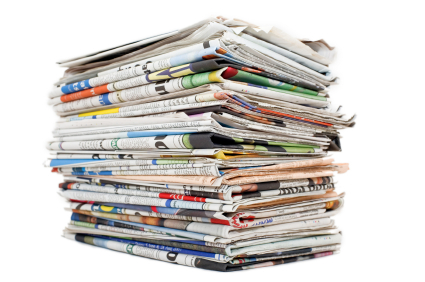It was interesting less for the 70 or so specific stops in the quick tour of nearly two millennia, fascinating though they were, than for it’s graphic illustration of a reality that those of us who love newspapers – or any other mainstream media for that matter – may not welcome but that we would nonetheless be idiotic to ignore.
Simply put, in a format where 1,400 years of media history were represented in 12 columns across two pages, newspapers got their last mention (except in relation to their use of the Internet) in column eight. That notation, incidentally, commemorates the advent of digitized production and computer use in newsrooms in 1967. Television is last heard from in 1980, the year that saw the launch of CNN. The entire final column in the timeline – one twelfth of the whole history of the media – is devoted exclusively to Internet developments. Likewise for column 11 except for digressions to announce the advent of DVD, camera phones and the Blackberry. The last true innovation in the world of newspapers deemed worthy of mention is the perfecting of phototypesetting back in 1947 (column seven, just past half) a few years before the appearance of the first color televisions and 11 years after the formation of the national treasure that is the CBC.
None of this makes me happy. In fact it’s depressing. I’m not a big fan of the Internet, which I’ve seen to be generally shallow and tacky when not outright imbecilic and sleazy. I’ve seen it answer the old question ‘what if every man had a printing press?’ and the answer has been that every man now also needs a shovel.
I am, on the other hand, a big fan of newspapers. I’ve worked for five of them and even owned a little one for a little while. Newspapers (usually) actually have standards – and a history to live up to. A noble history in fact, one that parallels the evolution of society, particularly in what we call the West, in its rise from ignorance and barbarism to whatever it is you call the state we find ourselves in today. Unintended consequences like environmental collapse notwithstanding that history has undeniably been one of social advancement, and newspapers have been there at least to mirror that progress and often to lead it.
That continues, and will. But for how long, though, is anybody’s guess. Because it’s really just a matter of old habits displaying their proverbial reluctance to get over themselves.
None of this applies to books – which are objects, possessions and hopefully minor works of art simply as such, regardless of their contents. They’re owned, treasured, displayed, reread and passed on.
Newspapers, on the other hand are information delivery systems. They can be beautifully produced but they are still, at best, recycled the next day. That being true, it becomes unconscionable to continue plowing through the pulp to deliver information in what is pretty much the most inefficient and environmentally catastrophic (however familiar and beloved) manner imaginable.
All for the sake of a little retraining. Starting with me. What I have to realize is that it’s not really newspapers that I’m so fascinated by. It’s really the world, the people in it, and the mess and magic that they’ve made of one another. The mess and magic that newspapers have long been the best window into.
It is obviously time to shuffle over to a different window. The difference in cost, economic and environmental, between online and pulp-based publication – for an intellectually indistinguishable result, emotions are something else – absolutely beggars comparison.
Then there are the readers. Retraining-wise, I mean. I’ve heard it from more than one potential advertiser already. Do you think people will go online to read the news?
Well, let me tell you. Short answer: Yes. Just look at the timeline.
Slightly longer answer: Yes. Because we’ll put the news up here like they can’t get anywhere else. Faster than they can get it anywhere else. And we’ll use whatever means necessary to make sure they know that’s what we’re doing. We’ll even occasionally use outmoded methods such as print. For the time being. And whatever else we can think of.
So stay tuned. It’s a transition whose time has come.
(30)
By Dennis Stranack – May 27, 2008
A few weekends back the Globe and Mail ran a two-page spread featuring playwright and novelist Rick Salutin’s musings following his stroll through the newly opened ‘Newseum’ in Washington, D.C.
Far more interesting, not that I have anything against musings, was a timeline that ran as a sidebar to the main piece, bulleting the entire history of the media from the first known wood-block-printed Buddhist scripture sometime before the year 705 right up to Google’s recent failed attempt to acquire Yahoo! for 47.5 billion bucks.



